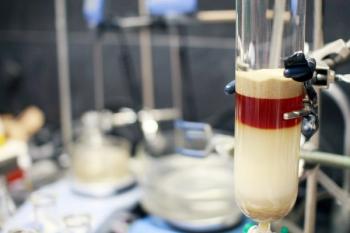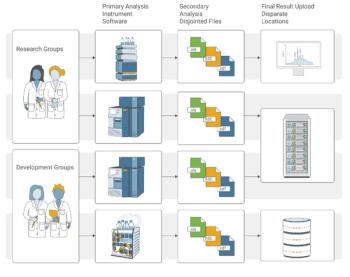
- November 2023
- Volume 19
- Issue 11
- Pages: 11–15
Tips & Tricks: GPC/SEC Calibration in DMF and DMAc
How to overcome calibration issues in GPC/SEC using DMF and DMAc.
Molar mass determination by gel permeation chromatography/size‑exclusion chromatography (GPC/SEC) requires elution to be governed by the size of the eluting macromolecules, and should not be influenced by enthalpic interaction with the stationary phase. This condition must be fulfilled by the analyte and—less considered—by the calibrant. Undesired effects on calibrant elution are known to exist when running GPC/SEC in highly polar eluents such as dimethylformamide (DMF) or dimethylacetamide (DMAc). However, these solvents are frequently applied in GPC/SEC. This instalment of Tips & Tricks will provide information on how to overcome calibration issues in GPC/SEC using these solvents.
Gel permeation chromatography/size-exclusion chromatography (GPC/SEC) provides an easy and effective way for molar mass determination of polymers and macromolecules. For molar mass determination, the molecules are chromatographically separated by their size in solution.
In modern GPC/SEC, size-based separation is achieved using chromatographic columns packed with rigid porous particles. Analytes with a smaller size than the pores of the packing can enter the pores, while larger molecules are excluded and are driven forward by the flowing eluent. As a consequence, small molecules elute later from the column than larger ones. By injecting a series of narrowly distributed polymeric standards of known molar mass, a calibration curve can be established, which relates molar mass to elution volume.
Since the 1960s, when rigid porous particles were introduced as a separation medium for GPC/SEC in organic solvents, particles based on cross-linked copolymers of styrene and divinylbenzene (SDVB) have been applied in numerous GPC/SEC separations. Polystyrene (PS) standards are now the most widely used GPC/SEC calibrants in organic solvents.
Polystyrene standards on SDVB‑based packings have been applied in numerous applications in solvents such as tetrahydrofuran (THF), chloroform, and toluene, as well as dimethylformamide (DMF) and dimethylacetamide (DMAc).
Calibration Curves on SDVB-Based Columns
Polystyrene standards are frequently applied in DMF or DMAc using SDVB-based column packings, although irregular GPC/SEC elution was reported for these combinations of eluents, standards, and packings. Calibration curves for polystyrene and polymethyl methacrylate (PMMA) on an SDVB-based column using DMAc as the eluent are compared in Figure 1.
At molar masses above approximately 5000 g/mol both calibration curves nearly coincided; however, the calibration curves differed at lower molar masses. The lower molar mass polystyrenes eluted later than the PMMAs of the same molar mass. Furthermore, the lowest molar mass polystyrene standard was not effectively separated from the system or solvent peaks, which are typically expected to be the last eluting peaks of a GPC/SEC chromatogram (not shown).
Since GPC/SEC separates based on size, not on molar mass, the deviation of the calibration curves does not necessarily prove adsorption of the lower molar mass polystyrenes. On the other hand, the lowest molecular weight PMMA (M = 596 Da) eluted at approximately the same elution volume as the polystyrene standard with a molecular weight of 1306 Da. Assuming a true GPC/SEC-separation exists, this would indicate that a PMMA of approximately 6 monomer units has the same size in solution as a polystyrene composed of approximately 13 monomer units, which, given the bulky phenyl groups that exist in polystyrene, is rather unlikely. Thus, non-size-based effects seem to influence polystyrene retention.
Adsorptive interactions usually increase with decreasing temperature, resulting in longer retention times. Thus, the samples were re‑run at 50 °C (Figure 2). Indeed, the difference in elution volume for the lowest molar mass PMMA and PS standards increased by nearly 40%. This might be a further indication of a non-size-based elution of the polystyrenes.
For the low polarity polystyrene standards, interactions with the nonpolar stationary phase are likely to exist, given the high polarity of the eluent. This is particularly true for the lower molar mass standards, which are expected to carry an alkyl chain end from the anionic synthesis. More polar PMMAs are expected to have a lower tendency to adsorption onto SDVB-based stationary phases.
For a more polar stationary phase, the polystyrene adsorption to the stationary phase is expected to decrease.
Polystyrene and PMMA calibration curves were therefore established on a polyester-type and on a modified silica packing. Both packings are more polar than SDVB-based materials.
Calibration Curves on Polyester-and Silica-Based Columns
Comparisons of the calibration curves on polyester- and silica-based columns are presented in Figure 3 and Figure 4, respectively. Irrespective of the packing material, the calibration curves of PMMA and polystyrene superimpose over a large molar mass range, indicating an identical hydrodynamic size in solution. Only at low molar masses do the calibration curves deviate slightly from each other.
To account for the different total column volumes, the percentage deviations of the lowest molar mass polystyrene and PMMA standards were determined. While the elution volume difference between the lowest molar mass polystyrene and PMMA amounted to 4% on the SDVB-based column, the volume difference on the polyester and silica-based columns was 2% and 1%, respectively. Thus, it can be assumed that polystyrenes exhibit stronger adsorptive interactions on the SDVB‑based column compared with the more polar packing materials.
Calibration of GPC/SEC Column Packings in DMAc or DMF
In agreement with the literature (1–4), the results indicate that polystyrenes exhibit interaction with SDVB-based packings when DMAc or DMF was applied as the eluent. This will affect the molar mass determination, and the molar masses of particularly low molar mass oligomers will be overestimated. Consequently, more polar column packings should be applied when polystyrenes are used as calibrants in DMAc or DMF. Alternatively, calibrants of higher polarity, for example, PMMA, could be used when columns packed with SDVB-based materials are utilized.
Both approaches have their pros and cons. While PMMA standards should be used for SDVB-based columns, polystyrene standards can also be used with more polar column packing. The advantage of this is that polystyrenes provide higher signal intensities than PMMAs because of the higher refractive index increment.
DIN EN ISO 13885-2:2021-11 requests the use of PMMA standards on SDVB-based columns for molar mass determination in DMAc (5).
Summary
- Molar mass determination by GPC/SEC requires not only interaction-free elution of the analyte but also of the calibrants.
- Low molar mass polystyrenes exhibit delayed elution on SDVB-based columns when run in DMAc or DMF.
- When running SDVB-based columns in DMF or DMAc, PMMA standards should be applied, as requested by DIN EN ISO 13885-2:2021-11.
- When polystyrene standards are applied in DMAc or DMF, columns containing packings of higher polarity are recommended.
References
(1) Dubin, P. L.; Koontz, S.; Wright, K. L. Substrate–Polymer Interactions in Liquid Exclusion Chromatography (GPC) in N,N-Dimethylformamide. J. Polym. Sci., Polym. Chem. Ed. 1977, 15, 2047–2057. DOI:
(2) Dawkins, J. V.; Hemming, M. Gel Permeation Chromatography with Crosslinked Polystyrene Gels and Poor and Theta Solvents for Polystyrene, 2. Separation Mechanism. Makromol. Chem. 1975, 176, 1795–1813. DOI:
(3) Cuo, C.; Provder, T.; Koehler, M. E. GPC-Viscometry Study in THF, DMF and DMAc. In Int. GPC-Symposium 1991.
(4) Lane, J. Don’t Lose It: Resolution and Reproducibility in GPC/SEC.
(5) DIN EN ISO 13885-2:2021-11, Gel Permeation Chromatography (GPC) - Part 2: N,N-Dimnthylacetamide (DMAc) as Eluent (ISO 13885-2:2020).
Wolfgang Radke studied polymer chemistry in Mainz (Germany) and Amherst (Massachusetts, USA) and is head of the contract analysis department at PSS - Part of Agilent. He is also involved in customer support and customized trainings. Email:
Articles in this issue
about 2 years ago
The Evolution of Breath Analysisabout 2 years ago
Alexandra Knauer Awarded Order of Meritabout 2 years ago
Schauenburg Analytics Ltd Appoints New CEOabout 2 years ago
Event Preview: The Green Analytical Chemistry Workshop (1st TGAC)about 2 years ago
Can Chemistry Be Accessible For Students With Visual Impairment?about 2 years ago
LCGC Blog: Are You Sick of Hearing About ChatGPT?about 2 years ago
Vol 19 No 11 The Column November 2023 Europe & Asia PDFabout 2 years ago
Vol 19 No 11 The Column November 2023 North American PDFNewsletter
Join the global community of analytical scientists who trust LCGC for insights on the latest techniques, trends, and expert solutions in chromatography.




